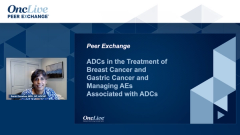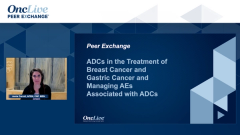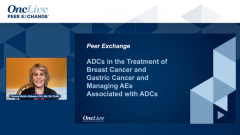
Role of T-DM1 in Patients With HER2+ Breast and Gastric Cancers
Shared insight on the clinical utility of trastuzumab emtansine in the second- and third-line settings of breast and gastric cancers.
Episodes in this series

Transcript:
Sarah Donahue, MPH, NP, AOCNP: Considering other therapies for use in later lines, where do you find the clinical utility of T-DM1 [trastuzumab emtansine]? For which patients would you consider continuing to use T-DM1 in the potential second- or specifically third-line settings? In my group, we use T-DM1, we have many patients still on it in their second-line setting because trastuzumab deruxtecan was just approved. I would definitely consider using it after trastuzumab deruxtecan for our newer patients who are going into their second lines of therapy. It’s really well tolerated generally, it has very little nausea, little fatigue. Patients can live their lives normally while they’re on it, so it’s a great treatment to offer patients and it has great control over their disease. It is something that I will continue to use with patients who are HER2-positive. Liz, can you briefly discuss the results of the GATSBY trial, which evaluated T-DM1 in gastric cancer?
Elizabeth Prechtel Dunphy, DNP, CRNP, AOCN: In the GATSBY trial, trastuzumab emtansine was compared with taxane therapy. There were 2 stages to the study. In the initial stage, there were 2 dosing levels for the trastuzumab emtansine, with 70 patients assigned to receive 3 to 6 mg/kg every 3 weeks, 75 patients to receive trastuzumab emtansine 2 to 4 mg/kg weekly, and 37 patients to receive taxane therapy. In the second stage of the study, the dose levels were 2 to 4 mg of the trastuzumab emtansine given weekly. With this stage, 153 patients were added in that arm of the study, and in the taxane-treated arm, there were an additional 80 patients. In this study, trastuzumab emtansine was not superior to taxane therapy in patients previously treated with HER2-positive advanced gastric cancer, with the median overall survival being 7.9 months in trastuzumab emtansine for the 2 to 4 mg/kg group, and 8.6 months with the taxane-treated patients. In the trastuzumab emtansine group, the patients had lower incidence of grade 3 or more adverse events. The most common for trastuzumab emtansine were anemia at around 26% and thrombocytopenia at around 11% ,compared to the taxane-treated arm, where the incidence of neutropenia was 39% and anemia was 18%.
Sarah Donahue, MPH, NP, AOCNP: Do you have any thoughts on why T-DM1 did not show efficacy in gastric cancer as it did with breast cancer?
Elizabeth Prechtel Dunphy, DNP, CRNP, AOCN: There’s some potential thought that was seen in some preclinical models. There were mechanisms of resistance due to transporters and the efflux of the emtansine out of the cell causing a decrease in the HER2 expression. There’s also evidence that HER2 status may be altered or lost during progression because of changes in the molecular profile of the tumor. We’ve seen discordant results in HER2 expression between primary metastatic tumors and sometimes even after first-line therapy and chemotherapy for metastatic disease with or without trastuzumab. There are a couple of thoughts or theories that explain why this can happen.
Sarah Donahue, MPH, NP, AOCNP: I wonder if in gastric cancer you are repeating biopsies throughout the patient’s progression to determine their HER2 status, or if that’s something that would be thought of down the line to check on?
Elizabeth Prechtel Dunphy, DNP, CRNP, AOCN: To this point in our practice, we haven’t repeated that for patients developing metastatic disease, but it may be something down the line that is looked at as we’re considering these different lines of therapies for patients. Theresa, I don’t know if that’s different in your practice.
Theresa Wicklin Gillespie, PhD, MA, RN, FAAN: We biopsy for the first incidence of metastatic disease, but if there’s further progression, we would not rebiopsy. But your point is well made because there may be changes with their HER2 expression that occur at [the] time of progression that may become important in the future.
Transcript edited for clarity.
Newsletter
Knowledge is power. Don’t miss the most recent breakthroughs in cancer care.





















































































